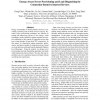Free Online Productivity Tools
i2Speak
i2Symbol
i2OCR
iTex2Img
iWeb2Print
iWeb2Shot
i2Type
iPdf2Split
iPdf2Merge
i2Bopomofo
i2Arabic
i2Style
i2Image
i2PDF
iLatex2Rtf
Sci2ools
NSDI
2008
2008
Energy-Aware Server Provisioning and Load Dispatching for Connection-Intensive Internet Services
Energy consumption in hosting Internet services is becoming a pressing issue as these services scale up. Dynamic server provisioning techniques are effective in turning off unnecessary servers to save energy. Such techniques, mostly studied for request-response services, face challenges in the context of connection servers that host a large number of long-lived TCP connections. In this paper, we characterize unique properties, performance, and power models of connection servers, based on a real data trace collected from the deployed Windows Live Messenger. Using the models, we design server provisioning and load dispatching algorithms and study subtle interactions between them. We show that our algorithms can save a significant amount of energy without sacrificing user experiences.
Computer Networks | Connection Servers | Long-lived Tcp Connections | NSDI 2008 | Server Provisioning Techniques |
| Added | 02 Oct 2010 |
| Updated | 02 Oct 2010 |
| Type | Conference |
| Year | 2008 |
| Where | NSDI |
| Authors | Gong Chen, Wenbo He, Jie Liu, Suman Nath, Leonidas Rigas, Lin Xiao, Feng Zhao |
Comments (0)

